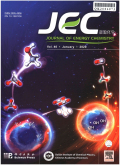- 钛学术文献服务平台 \
- 学术期刊 \
- 工业技术期刊 \
- 石油与天然气工业期刊 \
- 能源化学期刊 \
Passivation agent with dipole moment for surface modification towards efficient and stable perovskite solar cells
Passivation agent with dipole moment for surface modification towards efficient and stable perovskite solar cells
基本信息来源于合作网站,原文需代理用户跳转至来源网站获取
摘要:
Recently,there has been renewed interest in interface engineering as a means to further push the perfor-mance of perovskite solar cells closer to the Schockly-Queisser limit.Herein,for the first time we employ a multi-functional 4-chlorobenzoic acid to produce a self-assembled monolayer on a perovskite surface.With this interlayer we observe passivation of perovskite surface defects and a significant suppression of non-radiative charge recombination.Furthermore,at the surface of the interlayer we observe,charge dipoles which tune the energy level alignment,enabling a larger energetic driving force for hole extrac-tion.The perovskite surface becomes more hydrophilic due to the presence of the interlayer.Consequently,we observe an improvement in open-circuit voltage from 1.08 to 1.16 V,a power conver-sion efficiency improvement from 18% to 21% and an improved stability under ambient conditions.Our work highlights the potential of SAMs to engineer the photo-electronic properties and stability of per-ovskite interfaces to achieve high-performance light harvesting devices.

推荐文章
Snowball Earth at low solar luminosity prevented by the ocean–atmosphere coupling
Faint Young Sun paradox
Carbon dioxide
Earth system
Siderite
基于complex moment的圆度测量和图像检索
complex moment
圆度测量
梯度
图像结构相似度
图像检索
Statistics matters in interpretations of non-traditional stable isotopic data
Isotopic data processing
Error propagation
Significant digits
Difference between means with uncertainties
Geochemical tracing and modeling of surface and deep water-rock interactions in elementary granitic
Weathering
Water pathways
U activity ratios
Sr isotope ratios
Anthropogenic gases (CFC,SF6)
CZO
内容分析
关键词云
关键词热度
相关文献总数
(/次)
(/年)
引文网络
引文网络
二级参考文献 (0)
共引文献 (0)
参考文献 (0)
节点文献
引证文献 (0)
同被引文献 (0)
二级引证文献 (0)
2022(0)
- 参考文献(0)
- 二级参考文献(0)
- 引证文献(0)
- 二级引证文献(0)
引文网络交叉学科
相关学者/机构
期刊影响力
能源化学
主办单位:
中国科学院大连化学物理研究所
中国科学院成都有机化学研究所
出版周期:
双月刊
ISSN:
2095-4956
CN:
10-1287/O6
开本:
出版地:
大连市中山路457号
邮发代号:
创刊时间:
语种:
eng
出版文献量(篇)
2804
总下载数(次)
0
总被引数(次)
7996
期刊文献
相关文献
推荐文献
- 期刊分类
- 期刊(年)
- 期刊(期)
- 期刊推荐
一般工业技术
交通运输
军事科技
冶金工业
动力工程
化学工业
原子能技术
大学学报
建筑科学
无线电电子学与电信技术
机械与仪表工业
水利工程
环境科学与安全科学
电工技术
石油与天然气工业
矿业工程
自动化技术与计算机技术
航空航天
轻工业与手工业
金属学与金属工艺
能源化学2022
能源化学2021
能源化学2020
能源化学2019
能源化学2018
能源化学2017
能源化学2016
能源化学2015
能源化学2014
能源化学2013
能源化学2012
能源化学2011
能源化学2010
能源化学2009
能源化学2008
能源化学2007
能源化学2006
能源化学2005
能源化学2004
能源化学2003
能源化学2002
能源化学2001

 免费查重
免费查重










